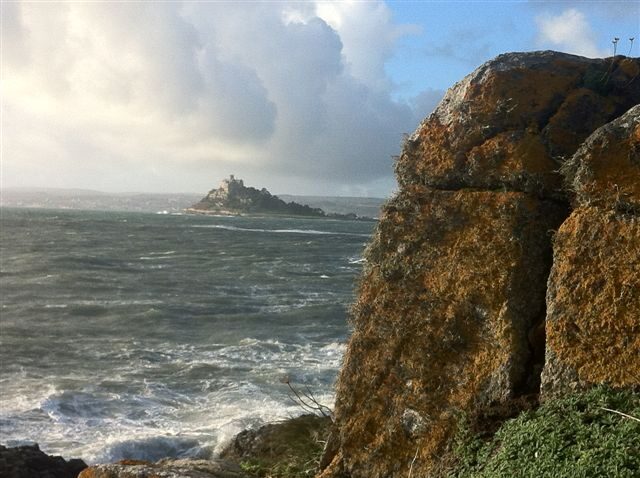St.Michael's Mount Marazion,Kernow in a mild winter storm.
The Cornish coastline looking across to a famous Cornish locality which was at one time a Monastic site and then a Civil War Castle and then a private home.
When the Cornish arrived in the islands,before 2000 years ago, that later the Romans called Pridan they gave names to the scenery and natural features that they saw and lived amongst, in their own language.
The Cornish were Celtic and spoke a Celtic Language and thus they gave their names to the Land.
To give one example they gave the name Carreg Los yn Cos the Grey Rock in the Woods to St.Michael's Mount because at that time the sea levels were lower and the rock which is now an island was surrounded by trees. The rock was obviously visible well above those trees and bushes. Today at low tide and if the sands have been scoured away and the wind and tide is in the right direction it is still possible to find examples of the submerged forest that grew on what was then above the sea level.
The remaining deposits of the submerged land are indeed as old as 4,000 years.Many younger years of deposits have been eroded away.
Sea levels and land levels have changed.They will continue to change.
This site is a site set up to link us closer to those who have an interest in Cornish Culture,History,Mining,Minerals and Geology and perhaps coming to visit Kernow.
Finally as a result of further migration of other groups following the Cornish Celts, principally of Saxons, Angle, Jutes, Vikings and Normans to name a few the name of the islands became changed to Britain spelt today with a B and this has remained ever since.
It is rather interesting, however,that there is a Cornish place name with the P still in place! This is a site on the Lizard Peninsula which may allude to Prindan. It was occupied by a Second World War Airfield and still part of a moorland farm used for grazing stock. Predannick or Predannack or Pradnack may be linked to the name the Romans write down as Predan.It is an interesting locality as it was a source of Native copper occurring in the Serpentinite Rocks of the Lizard and exploited by early Bronze age and Iron age Celts and was the source of the largest single piece of natural copper now in the Natural History Museum .The specimen was from the Ghost Mine/Pradnack Mine.
The Cornish were termed Wealas by these incoming Saxon groups-a term translated from Old English as the word for Foreigner or Stranger. And so we have the Welsh/Wales/Cornwelsh/Cornwalles/Cornwall- now being used to describe the Cornish as foreigners by later incoming tribes and peoples.
It is perhaps ironic that the Celts are termed strangers in their own Lands.
So we use the term Kernow to identify this land west of England.And Kembry to designate the land to the north by sea from us- alias Cymru. NB below,(Marghas dy'yow/Thursday's Market)
And so we write the locality of photograph above as St.Michael's Mount,near Marazion Kernow.UK.
